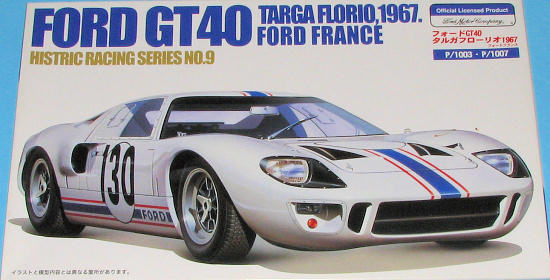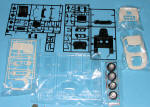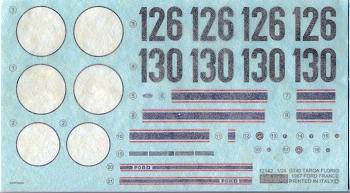
Fujimi 1/24 Ford GT40 'Targa Florio 1967'
| KIT #: | 12142 |
| PRICE: | $25.15 from GreatModels |
| DECALS: | Two options |
| REVIEWER: | Scott Van Aken |
| NOTES: | Curbside |

| HISTORY |
The Ford GT40 was a high performance sports car and winner of the 24 hours of Le Mans four times in a row, from 1966 to 1969 (in 1967 with a different body, though). It was built to win long-distance sports car races against Ferrari (who won at Le Mans six times in a row from 1960 to 1965).
The car was named the GT (for Grand Tourisme) with the 40 representing its overall height of 40 inches (1.02 m, measured at the windshield) as required by the rules. Large displacement Ford V8 engines (4.7 L and 7 L) were used, compared with the Ferrari V12 which displaced 3.0 L or 4.0 L.
Early cars were simply named "Ford GT". The name "GT40" was the name of Ford's project to prepare the cars for the international endurance racing circuit, and the quest to win the 24 Hours of Le Mans. The first 12 "prototype" vehicles carried serial numbers GT-101 through GT-112. The "production" began and the subsequent cars, the MkI, MkIIs, MkIIIs, and MkVs, numbered GT40-P-1000 through GT40-P-1145, were officially "GT40s". The name of Ford's project, and the serial numbers dispel the story that "GT40" was "only a nickname."
The Mk.I GT40 was the first car to race and to many the most aesthetically pleasing. Early prototypes were powered by 4.2 L (260 cu.in) engines; production models were powered by 4.7 L (289 cu.in) engines, also used in the Ford Mustang. Several prototype models had roadster bodywork.
The first chassis built by Abbey Panels of Coventry was delivered on March 16, 1963. The first "Ford GT" the GT/101 was unveiled in England on April 1 and soon after exhibited in New York.
It was powered by the 4.2 L Fairlane engine with a Colotti transaxle, the same power plant was used by the Lola GT and the single-seater Lotus 29 that came in a highly controversial second at the Indy 500 in 1963. (A DOHC head design was used in later years at Indy. It won in 1965 in the Lotus 38.)
The Ford GT40 was first raced in May 1964 at the Nürburgring 1000 km race where it retired with suspension failure after holding second place early in the event. Three weeks later at the 24 Hours of Le Mans, all three entries retired although the Ginther/Gregory car led the field from the second lap until its first pitstop. February 1965 saw Ken Miles and Lloyd Ruby take a Shelby American entered GT40 to victory in the Daytona 2000 km.
Though supplanted by the Mk.II in 1966, the Mk.I was upgraded and continued to soldier on, eventually winning a number of races. The number of detail differences between the various cars was legion and many feel that no two were exactly alike. Even the same car would go through changes as it was raced with the car that ended the season not being the same as the one that started.
| THE KIT |
 Fujimi
has taken many of the major differences into effect when doing their series of
Ford GTs. They are able to provide the bits and pieces to build a number of
different cars and to my knowledge, have at least six different boxings of the
Ford GT if not even more. My build of the GT40 Mk.II
several years ago was a
real pleasure and shows that Fujimi knows how to engineer car kits. This one is
no exception.
Fujimi
has taken many of the major differences into effect when doing their series of
Ford GTs. They are able to provide the bits and pieces to build a number of
different cars and to my knowledge, have at least six different boxings of the
Ford GT if not even more. My build of the GT40 Mk.II
several years ago was a
real pleasure and shows that Fujimi knows how to engineer car kits. This one is
no exception.
This particular boxing is for one of two Ford France cars that ran in the 1967 Targa Florio race in Sicily. This event was held over public roads and a real test of the car's ruggedness and endurance.
The kit is a curbside, which means no engine. However, the interior and chassis are both quite complete and detailed.
All Ford GT40s have some sections that are the same. In this case, it is the nose section, chassis and interior. Fujimi provides a clear sprue with all of the possible clear part options and as with some of the standard sprues, there are parts not used for this kit. The two Ford France cars differed in the rear end treatment with one car having twin tail lights on each side and the other only one. Probably the cheesiest part of the kit is the lack of proper photo etch screens for the rear end. The plastic ones provided just don't look very nice and most of those who build this kit will want to replace that with some screening.
Some of the bits that are particularly nice are the prepainted
aluminum wheels and the very nicely done
 pneumatic
rubber or vinyl tires. There is also an excellent gearbox representation so when
one looks into the back, one just doesn't see a blank plate.
pneumatic
rubber or vinyl tires. There is also an excellent gearbox representation so when
one looks into the back, one just doesn't see a blank plate.
Instructions are in Japanese with Gunze paint references. Markings are for one of two cars, both in white with red and blue stripes, differing in race numbers and rear end treatment. As they are not identical, one needs to pay attention to the areas in the instructions that refer to one car or the other. It is clearly marked. Decals look to be very nice and while my experience shows that the white areas are semi transparent, care in application on the white bodywork should alleviate any problems in that regard. I left the translucent wax paper over the sheet for the scan. It really isn't that cloudy looking. Decals are printed by Cartograf.
| CONCLUSIONS |
So another very nice Fujimi car kit and one of a racer at that. This is the sort of thing that I like to see. Although I know they would not sell, I'd love to see a series of Lola T-70 Spyders done like this. If you like racers and want something nice for the shelf, this is a good one to get.
| REFERENCES |
December 2008
You can get this and other fine kits at GreatModels
If you would like your product reviewed fairly and quickly, please contact me or see other details in the Note to Contributors.
Back to the Previews Index Page